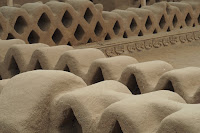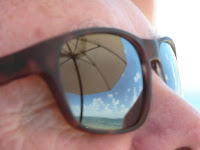Salaverry, Peru was our first port of call. We inched our way through the dusty streets of Trujillo, entertained, and at the same time terrified, by some of the antics of the drivers before the distraction of an impressive shoreline came into view.


 While agriculture was governed by the amount of available water the Chimu benefited from living close to one of the world's richest fishing grounds and this was documented in the friezes that decorated so many of their buildings with fish and seabirds celebrated in the relief design.
While agriculture was governed by the amount of available water the Chimu benefited from living close to one of the world's richest fishing grounds and this was documented in the friezes that decorated so many of their buildings with fish and seabirds celebrated in the relief design.
 The Incas conquered the city in the 15th Century taking many of Chan Chan's artisans to their own capital in Cuzco. Later the site was pillaged as the Spaniards removed gold, silver and other precious items.
The Incas conquered the city in the 15th Century taking many of Chan Chan's artisans to their own capital in Cuzco. Later the site was pillaged as the Spaniards removed gold, silver and other precious items.
In stark contrast to the honking horns and traffic chaos, our excursion to the UNESCO World Heritage site of Chan Chan, the excavated Chimu city. Presumed to be the largest adobe construction in the New World, Chan Chan was once the capital of the Chimu civilization, predecessors of the Incas.
The adobe buildings were fashioned to create a sophisticated city with richly decorated palaces and temples, adobe brick houses and storage facilities. The relief patterns decorating some of the more important buildings depict birds and animals, their repetitive simplicity pleasing to the eye.
The Chimu civilization endured for 600 years and at its height the population was estimated at 50,000.
A strict class system existed and was vested in the belief that the sun populated the world by creating three eggs - gold for the ruling classes, silver for their wives and copper for everyone else.
While the city was wealthy it lacked water because of its desert location and minimal rainfall so the Chimu worked to create a network of irrigation channels to address the lack of water. Ironically these days what is left of Chan Chan is threatened by too much water because of a changing climate.
 |
| Chan Chan's impressive city walls |


 While agriculture was governed by the amount of available water the Chimu benefited from living close to one of the world's richest fishing grounds and this was documented in the friezes that decorated so many of their buildings with fish and seabirds celebrated in the relief design.
While agriculture was governed by the amount of available water the Chimu benefited from living close to one of the world's richest fishing grounds and this was documented in the friezes that decorated so many of their buildings with fish and seabirds celebrated in the relief design. The Incas conquered the city in the 15th Century taking many of Chan Chan's artisans to their own capital in Cuzco. Later the site was pillaged as the Spaniards removed gold, silver and other precious items.
The Incas conquered the city in the 15th Century taking many of Chan Chan's artisans to their own capital in Cuzco. Later the site was pillaged as the Spaniards removed gold, silver and other precious items.
Stopping for a few moments to consider the fragility of empires, the sound of the crashing surf beyond the city walls and the rising sea mist added a certain mystique to our step back in time.
What would the Chimu have thought of the traffic we wondered.

















































